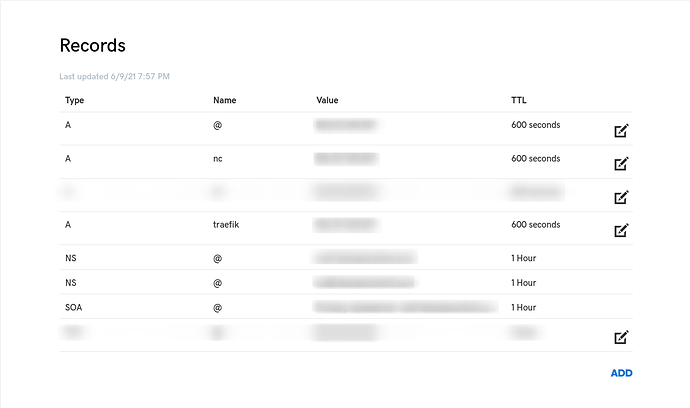Ok, after many hours of frustation I got it to work! I ended up using Traefik as @wwe suggested (thanks a lot btw) with Letsencrypt to get HTTPS. I did not follow his tutorial but I ended up doing something similar. I installed both Nextcloud and Traefik as Docker containers so it’s easier to manage. Make sure to port foward ports 80 and 443 to whatever machine you’re using for hosting. You have to do this from your modem, google your exact model to find out how to do it. Also, I bought a domain name (I needed it anyways to host a personal website) and made sure to make A records for each subdomain. Here is what I did (I used Godaddy):
This way if I go to traefik.mywebsite.com I can access my Traefik dashboard and if I go to nc.mywebsite.com I can access my Nextcloud server. The blurred part on the A records is my external ip address. You can check yours here. Ignore the two other blurred entries.
The files you will need to create are the following:
mkdir traefik
mkdir traefik/letsencrypt
mkdir nextcloud
touch traefik/docker-compose.yml
touch traefik/dynamic.yaml
touch nextcloud/dynamic.yml
Then edit traefik/docker-compose.yml, traefik/dynamic.yaml and nextcloud/dynamic.yml to the following:
traefik/docker-compose.yml
version: "3.3"
services:
traefik:
image: traefik:latest
restart: unless-stopped
security_opt:
- no-new-privileges:true
ports:
- 80:80 # <== http
- 443:443 # <== https
- 8080:8080 # <== :8080 is where the dashboard runs on
command:
## API Settings - https://docs.traefik.io/operations/api/, endpoints - https://docs.traefik.io/operations/api/#endpoints ##
- --api.insecure=true # <== Enabling insecure api, NOT RECOMMENDED FOR PRODUCTION
- --api.dashboard=true # <== Enabling the dashboard to view services, middlewares, routers, etc...
- --api.debug=true # <== Enabling additional endpoints for debugging and profiling
## Log Settings (options: ERROR, DEBUG, PANIC, FATAL, WARN, INFO) - https://docs.traefik.io/observability/logs/ ##
- --log.level=DEBUG # <== Setting the level of the logs from traefik
## Provider Settings - https://docs.traefik.io/providers/docker/#provider-configuration ##
- --providers.docker=true # <== Enabling docker as the provider for traefik
- --providers.docker.exposedbydefault=false # <== Don't expose every container to traefik, only expose enabled ones
- --providers.file.filename=/dynamic.yaml # <== Referring to a dynamic configuration file
- --providers.docker.network=web # <== Operate on the docker network named web
## Entrypoints Settings - https://docs.traefik.io/routing/entrypoints/#configuration ##
- --entrypoints.web.address=:80 # <== Defining an entrypoint for port :80 named web
- --entrypoints.web-secured.address=:443 # <== Defining an entrypoint for https on port :443 named web-secured
## Certificate Settings (Let's Encrypt) - https://docs.traefik.io/https/acme/#configuration-examples ##
- --certificatesresolvers.mytlschallenge.acme.tlschallenge=true # <== Enable TLS-ALPN-01 to generate and renew ACME certs
- --certificatesresolvers.mytlschallenge.acme.email=your-email@whatever.com # <== Setting email for certs
- --certificatesresolvers.mytlschallenge.acme.storage=/letsencrypt/acme.json # <== Defining acme file to store cert information
volumes:
- ./letsencrypt:/letsencrypt # <== Volume for certs (TLS)
- /var/run/docker.sock:/var/run/docker.sock # <== Volume for docker admin
- ./dynamic.yaml:/dynamic.yaml # <== Volume for dynamic conf file, **ref: line 27
networks:
- web # <== Placing traefik on the network named web, to access containers on this network
labels:
#### Labels define the behavior and rules of the traefik proxy for this container ####
- "traefik.enable=true" # <== Enable traefik on itself to view dashboard and assign subdomain to view it
- "traefik.http.routers.api.rule=Host(`traefik.mywebsite.com`)" # <== Setting the domain for the dashboard
- "traefik.http.routers.api.service=api@internal" # <== Enabling the api to be a service to access
container_name: traefik
networks:
web:
external: true
traefik/dynamic.yml
## Setting up the middleware for redirect to https ##
http:
middlewares:
redirect:
redirectScheme:
scheme: https
nextcloud/docker-compose.yml
version: "3.3"
services:
nextcloud-db:
image: postgres:latest
restart: on-failure
environment:
POSTGRES_USER: yourusername
POSTGRES_PASSWORD: yourpassword
POSTGRES_DB: nameforyourdatabase
PGDATA: /var/lib/postgresql/data/pgdata
volumes:
- "/path/to/folder/nextcloud-db:/var/lib/postgresql/data"
networks:
- nextcloud-net
container_name: nextcloud-db
nextcloud:
image: nextcloud:latest
restart: on-failure
depends_on:
- nextcloud-db
environment:
POSTGRES_DB: "nameforyourdatabase"
POSTGRES_USER: "yourusername"
POSTGRES_PASSWORD: "yourpassword"
POSTGRES_HOST: "nameforyourhost"
volumes:
- "/path/to/folder/nextcloud:/var/www/html"
networks:
- nextcloud-net
- web
labels:
#### Labels define the behavior and rules of the traefik proxy for this container ####
- "traefik.enable=true" # <== Enable traefik to proxy this container
- "traefik.http.routers.nextcloud.rule=Host(`nc.mywebsite.com`)" # <== Your Domain Name goes here for the http rule
- "traefik.http.routers.nextcloud.entrypoints=web" # <== Defining the entrypoint for http, **ref: line 30
- "traefik.http.routers.nextcloud.middlewares=redirect@file" # <== This is a middleware to redirect to https
- "traefik.http.routers.nextcloud-secured.rule=Host(`nc.mywebsite.com`)" # <== Your Domain Name for the https rule
- "traefik.http.routers.nextcloud-secured.entrypoints=web-secured" # <== Defining entrypoint for https, **ref: line 31
- "traefik.http.routers.nextcloud-secured.tls.certresolver=mytlschallenge" # <== Defining certsresolvers for https
container_name: nextcloud
networks:
web:
external: true
nextcloud-net:
external: true
Make sure to read these files and edit them to fit your info accordingly
After all that you’re ready to get the containers working! Just create the networks and run the containers:
docker network create web
docker network create nextcloud-db
cd traefik && docker-compose up -d
cd ../nextcloud && docker-compose up -d
These commands will create the web and nextcloud-net networks and will create containers traefik, nextcloud and nextcloud-db. This method will work (at least it did for me) so be sure to follow this tutorial carefully understanding each step.
I hope this is useful for someone! I will mark this as solved now.

